SMALLMOUTH BASS
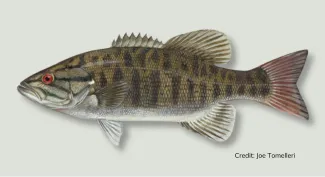
The summer season isn't complete without a wet wading trip to one of Oklahoma's clear-water streams! Oklahoma streams are filled with an array of catchable species, highlighted by the smallmouth bass. While the state has an abundance of clear-water rivers and creeks, only a handful have public access opportunities. In this guide we'll break down the top tips for catching smallmouth bass as well as the best public access destinations.
Oklahoma is home to three strains of smallmouth bass, the non-native Tennessee strain and the native Neosho and Ouachita strains. The Tennessee strain has been used to stock lakes across the state due to its penchant for slow flow living and larger attainable weight. Neosho and Ouachita strains like the faster flowing streams and rarely exceed 14 inches. There is overlap where Neosho and Ouachita strain watersheds are impounded by reservoirs that have been stocked with Tennessee strain (Neosho: Arkansas River Drainage; Ouachita: Red River Drainage).
Smallmouth bass are best caught during the late-spring, summer and early fall when water temperatures are above 60°F. Smallmouth bass can be caught on artifical lures and flies as well as natural/live bait.
SPECIES PROFILE
- Oklahoma Distribution
Smallmouth bass occur naturally in many eastern Oklahoma Ozark and Ouachita streams and tributaries. Fishable populations of the larger Tennessee strain exist in Skiatook, Lawtonka, Arbuckle, Tenkiller, Murray, Eufaula, Texoma and Broken Bow.
- Description
Black bass is a general term referring to largemouth, spotted and smallmouth bass and their hybrids. The three species are similar, but can be easily identified. Since water clarity can affect the color of a fish, color is not a reliable way to tell the basses apart. The most objective way to tell these species apart is by the relationship of the eye and the mouth hinge. On a spotted bass, the mouth hinge lines up vertically with the back edge of the eye; on a smallmouth bass, the mouth hinge vertically lines up in the middle or front edge of the eye; and on a largemouth bass, the mouth hinge vertically lines up behind the back edge of the eye.
- Habitat
Smallmouth bass inhabit clear, gravel-bottom-streams in Oklahoma. The best areas to fish for smallmouth within streams are in runs, pools and the shallows above riffles. In manmade impoundments smallmouth seek clear, clean water usually with a rocky substrate. Weedy areas along the shoreline, flats off channels and shelves are all good areas to find smallmouth.
- Natural Food Sources
- Crayfish
- Small fish
- Aquatic insects
- Terrestrial insects
- Worms
- Frogs
- Tadpoles
- Spawning
Spawning takes place in late spring when water temperatures are between 60° to 75°F. Nests are built on gravel bars in three to 20 feet of water. The male drives a spawn-ready female to the nest. After she lays her eggs, he searches out another, and then frequently a third female. Each female lays from 2,000 to 7,000 eggs per pound of body weight. Smallmouth males will guard the eggs and the fry until they swim up. While larger males will spawn more than once, they do put in effort to guard eggs and fry.
- Fish Facts
During the day, smallmouth seek the refuge of underwater cover. In the morning and evening they are often found prowling the shoreline of a "home" pool. Many people consider smallmouth bass one of Oklahoma's feistiest freshwater sport fish. Once you catch one on light tackle, you'll be looking forward to your next encounter.
FISHING TIPS
Smallmouth bass stream fishing offers a great opportunity during the dog days of summer to still get in on great fishing action. Summer fishing in ponds, lakes and reservoirs can be slow during the midday hours for bank anglers as the shallow water is just too warm for fish to be comfortable, but flowing streams come into their prime during the summer months. As fish retreat to shady or deeper areas of a stream during the midday hours, they are still very accessible to bank and wading anglers.
The biggest factor toward successful smallmouth bass stream fishing is water clarity. It is important to monitor rain forecasts and water gauges for optimal fishing conditions. The slightest stain in an otherwise clear-water stream can shut the bite completely down. Fortunately, if it's not flooding, Oklahoma's streams clear up quickly. If you don't live in the area you're fishing or know how to decipher USGS stream gauge data, you can always contact the local Game Warden for stream conditions at public access sites in their area.
Soft plastic grubs, tubes, swim-baits, worms and creatures in the 1.5" to 3" variety paired with a 1/32nd to 1/16th ounce jig-head are going to yield the most bites. Keep your offering in shades of green, brown, black, white or orange. Soft plastic baits labeled green pumpkin are a great starting point.
Larger soft plastic baits in the 3" to 5" variety usually need to be paired with a 1/8th to 1/4th ounce jig-head, but can be quite effective for big fish in the deepest holes and runs.
Crank-baits and jerk-baits in shad, bluegill and crayfish patterns will find success. As will naturally colored swim jigs and bladed jigs paired with a similarly colored soft plastic trailer. Inline spinnerbaits in shades of green, brown, black and white in the 1/8th to 1/4th ounce variety can produce bites in pools and runs.
Early morning and late evening hours can produce willing topwater takers. Walk-the-dog lures, poppers, buzz-baits and frogs are good options for drawing surface strikes.
Fly anglers can find success stripping jig-head and bead-head flies like Clouser Minnows and Woolly Buggers. Hatches such as mayfly and caddis provide dry fly opportunities along with terrestrial patterns like hoppers and stimulators. Stonefly, pheasant tail and rubber-legged yellow sally nymphs are also effective.
Approach runs, riffles, boulders and woody structure from downstream and make casts upstream or cross current and work your lure back to you without allowing it to get more than 45° downstream of you during the retrieve. Fish are looking to receive food from upstream or from ambush positions. Working a run or riffle section from upstream creates too many water disturbances that can spook fish, so it is always best to approach from downstream.
Pools can be fished this way as well, but can also be approached from upstream casting into the pool and allowing your lure to fall to the bottom then jig the lure back during the retrieve or if you have enough weight to hold the bottom, slowly retrieve the lure along the stream-bed. Try to make casts from a standing position that is least likely to send sediment and other disturbances into the pool.
Top Habitat to Target
- Woody structure - roots wads, log jams and tree lay-downs will hold fish all day long.
- Boulders - large rocks or rocky outcroppings create prime ambush spots and also funnel food.
- Riffles - these are shallow areas where current speeds are fast in relation to the rest of the stream. Look for seams and eddies created by woody structure or boulders that create soft water for fish to stay out of the faster current.
- Pools - particularly the beginning of the pool where the shallow riffle section dumps into the pool. Pools are created by turns in the river or natural impediments like log jams.
- Runs - a run is the section between a pool and riffle where water depth and current speed are consistent. Boulders, cut-banks, rocky bank outcroppings and woody structure are great places to target in a run. These areas often hold the largest fish.
- Tail-outs - the area at the end of a run where current speed increases as water moves into a riffle section. Tail-outs with shaded areas or a piece of structure are most desirable.
Rod/Reel Setup
- Light to Medium rod
- Spinning, spincasting or baitcasting reel
- 4-pound to 8-pound test line
Top Lures
- Tube
1.5" to 3" tube in shades of green, brown, black, white or orange
- Editor's pick: 1.5" Bass Pro Shops Tournament Series Squirmin' Squirt Tube in Green Pumpkin Red Flake paired with a 1/32nd ounce Bass Pro Shops Squirt Head
Image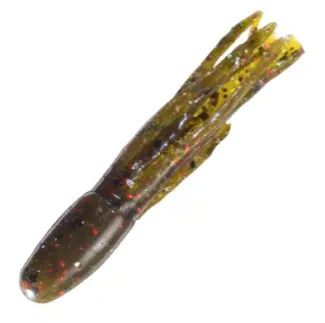
- Curly Tail Grub
2" to 4" curly tail grub in shades of green, brown, black, white or orange
- Editor's pick: 3" Zoom Fat Albert Grub in Rootbeer Pepper Green Flake, Watermelon/Red Flake, Pumpkin or Cotton Candy paired with a 1/16th ounce jig-head
Image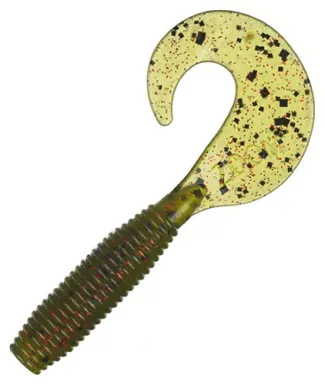
- Twin Tail Grub
2" to 4" twin tail grub in shades of green, brown, black, white or orange
- Editor's pick: 4” Chompers Skirted Twin Tail Grub in Rootbeer Green Flake paired with a 1/16th to 1/8th ounce jig-head
Image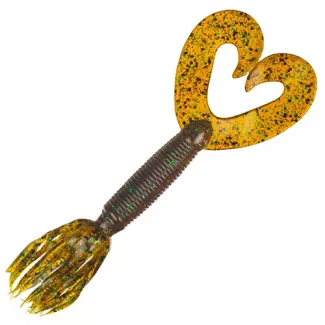
- Creature
1.5" to 4" crayfish, hellgrammite, lizard and baby brush hog in shades of red, green, brown, black or orange
- Editor's pick: 3" Berkley Gulp! Hellgrammite in Green Pumpkin paired with a 1/15th ounce Z-Man Finesse ShroomZ JigheadZ in Green Pumpkin
Image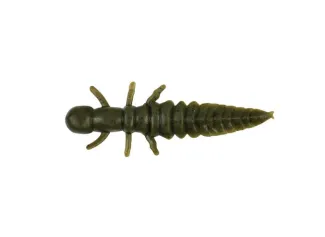
- Fluke
3" to 5" fluke in shades of green, brown, black, white or orange
- Editor's pick: 5-1/4” Zoom Super Fluke in White Pearl rigged weight-less and weed-less paired with a 3/0 to 5/0 offset hook
Image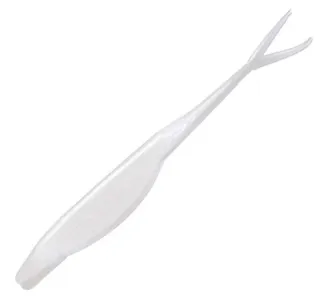
- Topwater
2" to 4" topwater lure in shades of green, brown, black, white or orange
- Editor's pick: 1-7/8” Heddon Tiny Torpedo in Brown Crawdad or 3-1/2” Heddon Chug’n Spook in Bone Silver
Image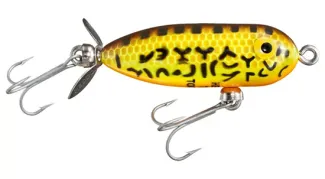 Image
Image
- Bank & Creek Bundle
Lurenet has you covered for Ozark and Ouachita stream favorites. Check out their Bank & Creek series offerings by clicking here.
Image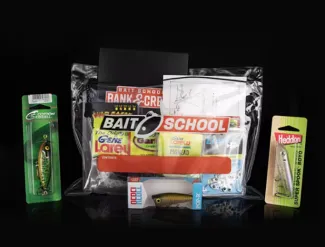
Top Bait
Natural/live bait can be drifted below a bobber or fished off the bottom with weight. Small- to medium-sized bait holding hooks and 1/8th to 1/2 ounce weights are ideal tackle.
- Hellgrammite
Family: Corydalidae (dobsonflies and fishflies), in the order Megaloptera (alderflies, dobsonflies, fishflies)
Description: Hellgrammites are the larvae of eastern dobsonflies. They are aquatic, somewhat flattened, and usually some shade of dark brown, tan, or black. Some people think they look like centipedes. The head is equipped with a pair of large, sharp pincers that can deliver a painful bite. The thorax has 3 pairs of legs, each tipped with a tiny pair of pincers. The segmented abdomen has 8 pairs of pointed, leg-like appendages along the sides, each with a cottony or hairy gill tuft at the base. There is a pair of hooked, leg-like appendages at the hind tip; these help keep the animal from being swept away in the water current.
The winged adults, called dobsonflies, are large, soft bodied, usually a drab gray, black, or brown, with prominent pincers and long antennae. Wings with conspicuous veins, usually folded down the length of the body when at rest. Pincers (mandibles) of females rather stubby and capable of inflicting a painful bite. Mandibles of males very long, tusklike, and incapable of hurting people due to lack of leverage.
Other Common Names: Eastern Dobsonfly Larva
Size: Up to 4 inches
Image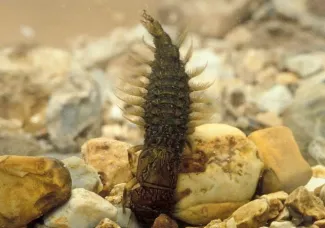
- Crayfishes
Family: Cambaridae (freshwater crayfish), in the order Decapoda (shrimp, crabs, and lobsters)
Description: To identify the different species, learn the names of crayfish body parts. Ten appendages are obvious: 4 pairs of walking legs plus 1 pair of pincers (chelipeds) (each pincer has a thumb-like movable finger attached to a “palm”). The body is divided into 2 main parts: at the front is the domelike carapace, comprising both head and thorax and to which the legs attach; and the abdomen, which is the obviously segmented hind part of the body, like the meaty “tail” of a lobster. The shallow indentation between the head and thorax is the cervical groove. At the front of the head are 2 types of “feelers”: 1 pair of antennae (the long ones) and 2 pairs of antennules (the short ones). The triangular extension of the carapace between the eyes is the rostrum.
Size: Depending on species, adult size ranges from 7/8-inch to more than 6 inches (Length excludes antennae and legs).
Image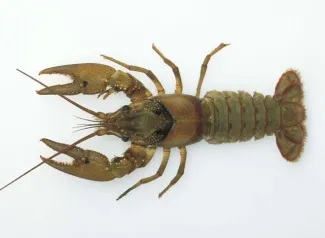
- Short-Horned Grasshoppers
Family: Acrididae (short-horned grasshoppers) in the order Orthoptera (grasshoppers, katydids, crickets)
Description: The short-horned grasshopper family includes many familiar jumpers. They are named for their antennae, which are relatively short compared to those in the "long-horned" (katydid) group. The antennae are usually less than half the length of the body and have fewer than 30 segments. Most short-horned grasshoppers are camouflaged with green, olive, tan, brown, or black, though some are quite colorful. Some have colorful wings that only show in flight. The hind legs are specialized for jumping; the mouthparts for chewing.
Like other members of order Orthoptera, short-horned grasshoppers have the first pair of wings long, narrow, fairly thick, and many-veined, functioning as a cover for the second pair, which are membranous and used for flying.
Image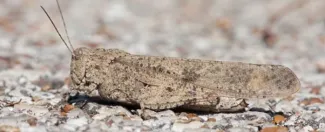
- Crickets
Family: Gryllidae (true crickets) in the order Orthoptera (grasshoppers, crickets, katydids)
Description: Field crickets and house crickets are celebrated singers. There are many species in North America, and they can be hard to tell apart. They have large heads, hind legs adapted for jumping, and stout, unmovable spines on the hind legs. Species may be black, brown, or tan. Adult females have a needlelike (but harmless) ovipositor extending outward from the abdomen; all have a pair of filament-like circi extending from the abdomen (each cercus functions like an antenna).
Members of the genus Gryllus are usually shiny black, and the different species are often best separated by singing pattern. The house cricket, Acheta domesticus, is light brown or tannish overall; the tan head has three dark cross-bands; the wings of adults extend beyond the tip of the abdomen.
Size: Usually ½–1 inch (not counting appendages; varies with species and age of individual).
Image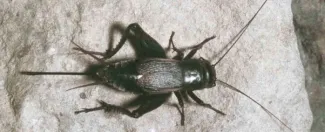
- Nightcrawlers
Canadian nightcrawlers are one of the largest commonly available worms. They are sometimes called "dew worms" because they are sometimes found outside in the early morning when there is morning dew still on the ground and nearby plants. The scientific name for them is Lumbricus terrestris. Other names include "lobworm" or just "nightcrawlers." Despite the name, Canadian nightcrawlers are believed to have originated in Europe.
Image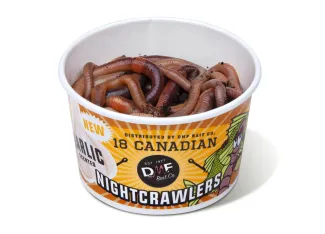
- Red Worms
Known under various common names such as manure worm, brandling worm, panfish worm, trout worm, tiger worm, and red wiggler worm, the red worm is a species of earthworm adapted to decaying organic material. These worms thrive in rotting vegetation, compost, and manure. They are epigean, meaning they crawl on the surface of soil, but are rarely found in soil.
Image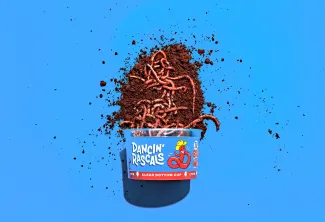
TRY ON THE FLY!
Interested in fly fishing for smallmouth bass in Oklahoma for the first time? Check out Native Waters Outfitters for guided opportunities this summer. Native Waters Outfitters are proud partners of ODWC's Stars and Stripes Program as well as Project Healing Waters Fly Fishing, a non-profit organization serving wounded military service members at Walter Reed Army Medical Center returning from combat in Iraq and Afghanistan.
Rod/Reel Setup
- 3-weight up to 7-weight fly rod with floating fly line, a 7.5' or 9' 6x up to 0x leader and 1 to 2 feet of 6x up to 0x tippet.
Top Flies
- Stripping Flies
- Size 2 Clouser Minnow in Sculpin, Silver Shiner or Olive and White
- Size 2 Bead-head Woolly Bugger in Olive, Brown or White
- Size 2/0 to Size 6 jig or bead-head fly in shades of green, brown, black, white or orange
- Editor's pick: Chocklett's Polar Changer in Tan
Image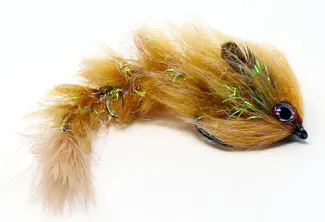
- Nymph Flies
- Size 8-12 Stonefly Nymph
- Size 14 Rubber-Legged Yellow Sally
- Size 16-20 Pheasant Tail Nymph
- Dry Flies
- Size 1 Bett's Bass Bug Popper
- Size 6 Rubber-Legged Hopper
- Size 10-14 Stimulator
PUBLIC ACCESS HIGHLIGHTS
- Barren Fork Creek
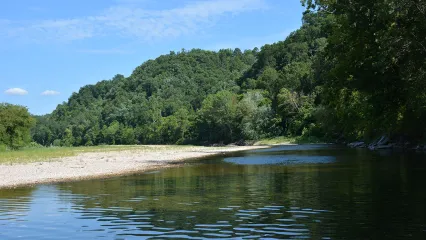
Barren Fork Creek is Oklahoma's premier smallmouth bass wet wading stream destination. What the fish lack in size they make up for in volume. There is very little in the way of bycatch, 95% of fish caught will be smallmouth bass. For the most part, bycatch will include different species of sunfish. Most smallmouth bass average between 6"-14", but there are a few fish over 14 inches in each section of the creek. With an average CFS around 200 and depth around 3 feet, it is an ideal location for new and young anglers to gain experience stream fishing. The packed cobble stream-bed makes for easy wading and wide gravel bars with little bank overhang makes for easy casting.
There are five public access locations along the creek. ODOT offers public access at the Eldon Bridge on HWY 51 (parking available to southeast of bridge). Grand River Dam Authority (GRDA) offers public access at Welling Bridge. Corps of Engineers maintains public access at Boy Scout Hole. ODWC offers public access at the Thomas A Bamberger Sr WMA and Barren Fork WMA.
There is no public camping on Barren Fork Creek, but float outfitters along the Upper Illinois River have traditional campgrounds, RV hookups and cabins depending on what best suits your needs. The Corps of Engineers and Oklahoma State Parks operate campgrounds around Tenkiller Lake and there is an abundance of other lodging and AirBNB opportunities in the area.
ODWC offers primitive camping along the Upper Illinois River at Round Hollow, Stunkard, Peavine Hollow, No Head Hollow and Echota public access sites. These sites are maintained in partnership with GRDA. GRDA collects a camping fee at these sites on the weekends and at their office on weekdays. Camping is $14/night and accommodates two vehicles and tents per site. For more information, contact GRDA Scenic River Operations (918) 456-3251.
Fishing Tips
1.5" to 3" tubes, grubs and swim-baits paired with a 1/32nd or 1/16th ounce jig-head are all that is needed at Barren Fork Creek. Green pumpkin is an excellent base color mixed with red and/or black flakes. Soft plastic baits in shades of green, brown, black, white and orange are also effective.
Fly anglers can find success stripping jig-head and bead-head flies like Clouser Minnows and Woolly Buggers. Hatches such as mayfly and caddis provide dry fly opportunities along with terrestrial patterns like hoppers and stimulators. Stonefly, pheasant tail and rubber-legged yellow sally nymphs are also effective.
Bait anglers can find success with a cup of nightcrawlers or red worms drifted below a bobber or fished off the bottom with a 1/8th to 1/4th ounce weight. Scooping up a handful of grasshoppers along the creek's banks is also an effective bait choice.
Due to the small size of the creek, anglers can cover a lot of water. Fish will be stacked up in reliable areas such as pools and woody structure, but don't overlook any inch of the creek. Some of the biggest fish can be found in shallow shaded areas.
Editor's Tip
My go-to is to buy a 15 pack of 1.5" Bass Pro Shops Tournament Series Squirmin' Squirt tubes in Green Pumpkin Red Flake and a 15 pack of 1/32nd ounce Bass Pro Shops Squirt Head jig-heads. I pre-rig the tubes with the jig-heads and put them back into the plastic pack the tubes came in along with a pair of line clippers. That fits into my chest pocket and allows me to wet wade unencumbered. Each tube will catch several fish before it needs to be changed out for a fresh one. I throw this rig on a 6'6" medium-light action rod with a spinning reel spooled with 6-pound test fluorocarbon line or on a 3-weight fly rod with floating line, 9' 4x leader and 2' of 5x tippet (1/64th ounce Squirt Heads work even better for fly casting).
Fishing Contact:
Game Warden:
Location:
Barren Fork Creek (Google Map) is located 15 miles east of Tahlequah on HWY 62.
Profile
- Cobble bottom, gravel bars, submerged timber, log jams, riffles, runs, pools
Drive Time
- From OKC: 3 hours
- From Tulsa: 1.5 hours
- From Muskogee: 1 hour
- From Tahlequah: 20 minutes
Bait & Tackle Nearby
- Walmart Supercenter
- Bait Barn
- Walmart Supercenter
- Mike's Outdoors
- Dunham's Sports
- Dave's Bait & Tackle
- Jimmy Houston Outdoors Store
Barren Fork Creek CFS Data
- Blue River
- Image
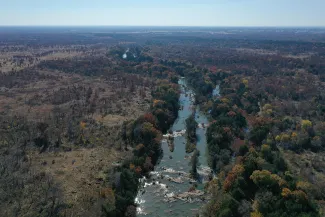
6.25 miles of public wading and bank access make the Blue River Public Hunting & Fishing Area, located 10 miles north of the South-Central town of Tishomingo, a true gem of public lands.
There are a few handicap accessible bank fishing areas around the campgrounds. Trails along the river's edge and multiple entrance locations provide ample opportunities for adventurous anglers to find a section of river all to theirself. Native surroundings and relatively deep water along the river banks can create hazardous conditions for children and pets throughout most of the property, but there are several family-friendly fishing areas around the campgrounds.
Try to stay on maintained trails when not in the water. "Bush-whacking" hazards include poison plants, venomous snakes, ticks and chiggers. Water pants instead of shorts are a great option if you plan to get off the beaten path.
ODWC manages first come, first serve free primitive campgrounds and latrines on the property. Must possess a valid Oklahoma hunting or fishing license, or a Conservation Passport to recreate on the area and use the campgrounds, unless exempt.
Fishing Tips
Blue River has lots of different types of river sections to target. Artificial lures and flies are effective in the fast moving water near waterfalls, tail-outs, pocket water and riffle runs. Naturally colored tubes, grubs and swim-baits are great artificial lure selections.
Bluegill and crayfish colored crank-baits, swim jigs and bladed jigs will also catch fish, but are more susceptible to getting hung up on snags. Topwater baits are a good choice in the early morning and late evening hours.
Fly anglers can find success stripping jig-head and bead-head flies like Clouser Minnows and Woolly Buggers. Hatches such as mayfly and caddis provide dry fly opportunities along with terrestrial patterns like hoppers and stimulators. Stonefly, pheasant tail and rubber-legged yellow sally nymphs are also effective.
Bait anglers can find success with a cup of nightcrawlers or red worms drifted below a bobber or fished off the bottom with a 1/8th to 1/4th ounce weight. Scooping up a handful of grasshoppers along the creek's banks is also an effective bait choice. Bait fished off the bottom is productive in slow moving pools, eddies and deep runs for a multitude of species.
Seams behind boulders or woody lay-downs and riffle runs through the pocket water are good places to find multiple fish stacked up. Deep runs and waterfall pools typically hold the largest fish.
Smallmouth bass are not heavily populated in the river, but most of the ones caught are large fish. By-catch will largely be spotted bass and different species of sunfish, with an occasional largemouth bass, channel catfish and crappie mixed in.
Editor's Tip
My favorite part of Blue River is the braided section above Desperado Spings. Each pocket of water will hold a spotted or smallmouth bass and catch rates can be exceptional. Tubes and curly tail grubs in shades of green pumpkin, watermelon or orange paired with a 1/16th ounce jig-head are the hot ticket at Blue River.
For chasing big smallmouth, I like a 2-1/4" Bass Pro Shops Magnum Squirt tube in Green Pumpkin Red Flake paired with a 1/15th ounce Z-Man Finesse ShroomZ JigheadZ in Green Pumpkin or a 3" Zoom Fat Albert grub in Rootbeer Green/Pepper Flake paired with a 1/16th ounce jig-head. Otherwise you can't go wrong with a 1.5" Bass Pro Shops Tournament Series Squirmin' Squirt tube in Green Pumpkin Red Flake paired with a 1/32nd ounce Bass Pro Shops Squirt Head jig-head.
Fishing Contact:
Game Warden:
(580) 320-2948, (580) 320-2950
Location:
Blue River (Google Map) is located 10 miles north of Tishomingo via HWY 377 and HWY 7.
Profile:
- Mostly hard bottom, boulders, submerged timber, waterfall pools, pocket water, runs, light vegetation
- Primitive camping areas
- Latrines
- Food/supplies at Scotty's Blue River One Stop
Drive Time:
- From OKC: 2 hours
- From Tulsa: 2.75 hours
- From Ada: 45 minutes
Bait & Tackle Nearby:
- Scotty's Blue River One Stop
- Walmart Supercenter
- Walmart Supercenter
Blue River CFS Data
- Honobia/Three Rivers WMA
- Image
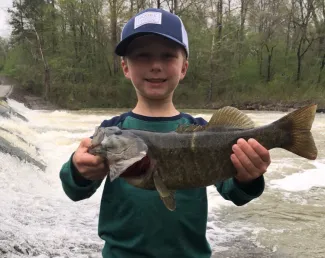
Honobia Creek WMA boasts more than 20 miles of streams and rivers offering anglers almost unlimited fishing opportunities. Plentiful smallmouth and largemouth bass, as well as a high population of green sunfish, can be found in the Little River (easy access here and here) and Jack Creek (easy access here, here, here and here). Little River is an excellent spot to catch good numbers of channel and flathead catfish.
The Glover River cuts right through the heart of Three Rivers WMA. The Glover is Oklahoma’s longest free flowing river. It is a great fishery for bass, sunfish and catfish. Access to the East Fork of the Glover can be found here. Access to the West Fork of the Glover can be found here, here, here, here, here and here.
Public access to reach these waterways is through Honobia WMA and Three Rivers WMA. These WMAs are made possible through partnerships with logging companies, so in addition to a state fishing license, unless exempt, anglers must also purchase a Land Access Permit ($40 resident, $85 nonresident).
Camping is not allowed on the WMAs, but lodging can be found in nearby towns and camping options are available at Sardis USACE, Lake Nanih Waiya, Clayton Lake State Park, Robbers Cave State Park, Talimena State Park, Lake Ozzie Cobb, Broken Bow USACE, Beavers Bend State Park, Pine Creek USACE, Raymond Gary State Park, Hugo Lake State Park, Hugo USACE.
Fishing Tips
1.5" to 3" tubes, grubs and swim-baits paired with a 1/32nd or 1/16th ounce jig-head are great artificial choices. Green pumpkin is an excellent base color mixed with red and/or black flakes. Soft plastic baits in shades of green, brown, black, white and orange are also effective.
Bluegill and crayfish colored crank-baits, swim jigs and bladed jigs will also catch fish, but are more susceptible to getting hung up on snags. Topwater baits are a good choice in the early morning and late evening hours.
Fly anglers can find success stripping jig-head and bead-head flies like Clouser Minnows and Woolly Buggers. Hatches such as mayfly and caddis provide dry fly opportunities along with terrestrial patterns like hoppers and stimulators. Stonefly, pheasant tail and rubber-legged yellow sally nymphs are also effective.
Bait anglers can find success with a cup of nightcrawlers or red worms drifted below a bobber or fished off the bottom with a 1/8th to 1/4th ounce weight. Scooping up a handful of grasshoppers along the creek's banks is also an effective bait choice.
Editor's Tip
My go-to is to buy a 15 pack of 1.5" Bass Pro Shops Tournament Series Squirmin' Squirt tubes in Green Pumpkin Red Flake and a 15 pack of 1/32nd ounce Bass Pro Shops Squirt Head jig-heads. I pre-rig the tubes with the jig-heads and put them back into the plastic pack the tubes came in along with a pair of line clippers. That fits into my chest pocket and allows me to wet wade unencumbered. The plastic pack from your soft bait of choice makes a great "river tackle box" that you can put an assortment of baits, hooks and weights in for the day. Be sure to separate the hooks and soft plastics back out when your done fishing or you'll find your "tackle box" with a bunch of rusted hooks and discolored plastics the next time you open it.
Fishing Contact:
Game Warden:
Location:
Glover River (Google Map) is located 8 miles southwest of Bethel via D1875 Rd and Wyr 56000 RD. Little River (Google Map) is located 16 miles southeast of Nashoba via Cloudy Nashoba Trail Rd and Pickens Creek Trail Rd.
Profile:
- Mostly hard bottom, boulders, submerged timber, waterfall pools, pocket water, runs, light vegetation
Drive Time:
- From OKC: 3.5 hours
- From Tulsa: 3 hours
- From McAlester: 1.5 hours
- From Durant: 2 hours
Bait & Tackle Nearby:
- Sardis Lake Custom Lures
- Rebel Bait Shop
- Walmart Supercenter
- Atwoods
- Lakeside One Stop
- Double K Bait & More
- D&J Bait N Grub
- B & B Bait & Tackle
- JC's Store
- JJ's Bait Shop
- Beavers Bend Marina
- Hookers Live Bait Fire & Ice
- Beavers Bend Fly Shop
- Walmart Supercenter
- Walmart Supercenter
- Red Barn Propane - Bait, Tackle
- Walmart Supercenter
Glover River CFS Data
- Illinois River
- Image
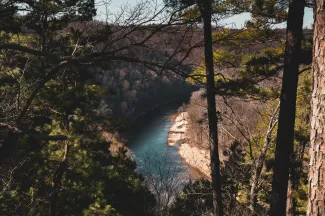
The Illinois River, a beautiful Ozark stream, is the primary tributary of Lake Tenkiller. It holds the most sizable population of river smallmouth over 14 inches in the state.
Float and wading opportunities are numerous. The Illinois River is lined with public access points and float operators. For a list of access points check out the Illinois River Float Guide.
The Corps of Engineers and Oklahoma State Parks operate campgrounds around Tenkiller Lake and there is an abundance of other lodging, camping and AirBNB opportunities in the area. Most float operators have some form of camping available on their property.
ODWC offers primitive camping along the Upper Illinois River at Round Hollow, Stunkard, Peavine Hollow, No Head Hollow and Echota public access sites. These sites are maintained in partnership with GRDA. GRDA collects a camping fee at these sites on the weekends and at their office on weekdays. Camping is $14/night and accommodates two vehicles and tents per site. For more information, contact GRDA Scenic River Operations (918) 456-3251.
Fishing Tips
1.5" to 3" tubes, grubs and swim-baits paired with a 1/32nd or 1/16th ounce jig-head are a great start to get lots of bites. Green pumpkin is an excellent base color mixed with red and/or black flakes. Soft plastic baits in shades of green, brown, black, white and orange are also effective.
3" to 5" twin tail grubs, tubes and worms in shades of green, brown, black and orange paired with a 1/8th ounce to 1/4 ounce jig-head will find bigger fish, but get bit less often. 4" to 5" white flukes have the same effect when fished weight-less and weed-less on a 3/0 to 5/0 offset hook.
Bluegill and crayfish colored crank-baits, swim jigs and bladed jigs will also catch fish. Pair a soft plastic twin tail grub to a swim jig or bladed jig for added enticement.
Topwater baits like walking dogs and torpedos are a good choice in the early morning and late evening hours.
Fly anglers can find success stripping jig-head and bead-head flies like Clouser Minnows and Woolly Buggers. Hatches such as mayfly and caddis provide dry fly opportunities along with terrestrial patterns like hoppers and stimulators. Stonefly, pheasant tail and rubber-legged yellow sally nymphs are also effective.
Bait anglers can find success with a cup of nightcrawlers or red worms drifted below a bobber or fished off the bottom with a 1/8th to 1/4th ounce weight. Scooping up a handful of grasshoppers along the river's banks is also an effective bait choice.
Editor's Tip
This is the river to take advantage of bigger profile baits and heavier weight. Dragging 4" and 5" twin tail grubs along the stream-bed, especially in pools, can find some nice-sized fish. The stretch between Round Hollow and Peavine is the most productive section of river year-round. The stretch from No Head Hollow downstream to the HWY 62 bridge has been known to produce some good fishing and has the least amount of commercial floaters during the summer months.
While mostly a recreational float crowd during the summer months, fish can still be caught. Focus on the shallow side of the river and back water, specifically areas with submerged timber or cut banks.
Peak fishing occurs in May and October when float traffic is at its lowest, but high catch rate days are still common in the summer, especially mid-week.
I like a 1.5" Bass Pro Shops Tournament Series Squirmin' Squirt tube in Green Pumpkin Red Flake paired with a 1/32nd ounce Bass Pro Shops Squirt Head jig-head and a 2-1/4" Bass Pro Shops Magnum Squirt tube in Green Pumpkin Red Flake or a 2-3/4" Z-Man Finesse TRD in California Craw paired with a 1/15th ounce Z-Man Finesse ShroomZ JigheadZ in Green Pumpkin.
Fishing Contact:
Game Warden:
Location:
Illinois River (Google Map) is located 3 miles east of Tahlequah via HWY 62 and HWY 10.
Profile:
- Cobble bottom, gravel bars, submerged timber, log jams, riffles, runs, pools
Drive Time:
- From OKC: 2.75 hours
- From Tulsa: 1.25 hours
- From Muskogee: 1 hour
- From Tahlequah: 10 minutes
Bait & Tackle Nearby:
- Walmart Supercenter
- Bait Barn
- Walmart Supercenter
- Mike's Outdoors
- Dunham's Sports
- Dave's Bait & Tackle
- Jimmy Houston Outdoors Store
Illinois River CFS Data
- Mountain Fork River
- Image
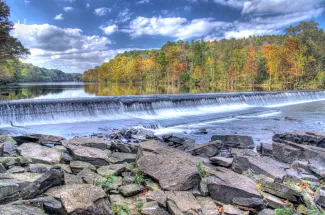
The Mountain Fork River flows into the north end of Broken Bow Lake. There are multiple access points throughout Ouachita WMA, the easiest being at the Narrows.
The Lower Mountain Fork River below Broken Bow Lake dam sports a year-round trout fishery. During the summer months, bass and walleye can be caught throughout Beavers Bend State Park, especially below the low water dam.
Lodging is available in nearby towns and Beavers Bend State Park and camping is available at Broken Bow USACE and Beavers Bend State Park.
Fishing Tips
1.5" to 3" tubes, grubs and swim-baits paired with a 1/32nd or 1/16th ounce jig-head are great artificial choices. Green pumpkin is an excellent base color mixed with red and/or black flakes. Soft plastic baits in shades of green, brown, black, white and orange are also effective.
Bluegill and crayfish colored crank-baits, swim jigs and bladed jigs will also catch fish, but are more susceptible to getting hung up on snags. Topwater baits are a good choice in the early morning and late evening hours.
Fly anglers can find success stripping jig-head and bead-head flies like Clouser Minnows and Woolly Buggers. Hatches such as mayfly and caddis provide dry fly opportunities along with terrestrial patterns like hoppers and stimulators. Stonefly, pheasant tail and rubber-legged yellow sally nymphs are also effective.
Bait anglers can find success with a cup of nightcrawlers or red worms drifted below a bobber or fished off the bottom with a 1/8th to 1/4th ounce weight. Scooping up a handful of grasshoppers along the rivers's banks is also an effective bait choice.
Editor's Tip
The Mountain Fork is a great walleye and white bass fishery during the spring rains. I prefer to fish it for bass in August, September and October when the water is typically at its clearest.
I like a 1.5" Bass Pro Shops Tournament Series Squirmin' Squirt tube in Green Pumpkin Red Flake paired with a 1/32nd ounce Bass Pro Shops Squirt Head jig-head and a 2-1/4" Bass Pro Shops Magnum Squirt tube in Green Pumpkin Red Flake or a 2-3/4" Z-Man Finesse TRD in California Craw paired with a 1/15th ounce Z-Man Finesse ShroomZ JigheadZ in Green Pumpkin.
Fishing Contact:
Game Warden:
Location:
Mountain Fork River (Google Map) is located 6 miles south of Smithville via US 259.
Profile:
- Mixed shoal/cobble bottom, boulders, submerged timber, pools, pocket water, runs, light vegetation
- Campgrounds
- Latrines
Drive Time:
- From OKC: 4 hours
- From Tulsa: 3.25 hours
- From McAlester: 2 hours
- From Durant: 2.5 hours
Bait & Tackle Nearby:
- Beavers Bend Marina
- Hookers Live Bait Fire & Ice
- Beavers Bend Fly Shop
- Walmart Supercenter
- Walmart Supercenter
- Red Barn Propane - Bait, Tackle
- Walmart Supercenter
Mountain Fork River CFS Data
Lower Mountain Fork River CFS Data
- Rock Creek
- Image
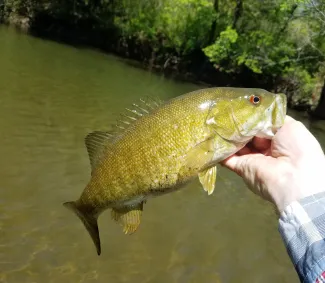
Rock Creek is a small tributary of Arbuckle Lake. It meanders its way through the town of Sulphur and the Chickasaw National Recreation Area.
Parking and access to the creek can be found below Veterans Lake. From there you can wet wade downstream to an old dry creek bed that will lead back up to the walking trail road. The channel widens and deepens after the first quarter-mile downstream.
Fishing above the falls and walking bridge gets into shallow water. There are some sunfish and roaming sucker fish to be caught in that section.
Lodging is available in nearby Sulphur and camping options are available at Chickasaw NRA.
Fishing Tips
1.5" to 3" tubes, grubs and swim-baits paired with a 1/32nd or 1/16th ounce jig-head are great artificial choices. Green pumpkin is an excellent base color mixed with red and/or black flakes. Soft plastic baits in shades of green, brown, black, white and orange are also effective.
Bluegill and crayfish colored crank-baits, swim jigs and bladed jigs will also catch fish, but are more susceptible to getting hung up on snags. Topwater baits are a good choice in the early morning and late evening hours.
Fly anglers can find success stripping jig-head and bead-head flies like Clouser Minnows and Woolly Buggers. Hatches such as mayfly and caddis provide dry fly opportunities along with terrestrial patterns like hoppers and stimulators. Stonefly, pheasant tail and rubber-legged yellow sally nymphs are also effective.
Bait anglers can find success with a cup of nightcrawlers or red worms drifted below a bobber or fished off the bottom with a 1/8th to 1/4th ounce weight. Scooping up a handful of grasshoppers along the creek's banks is also an effective bait choice.
Editor's Tip
The first quarter-mile downstream will yield a few fish, mostly sunfish. Once the river channel begins to widen and water depths average around waist deep, bite rates can be much more prolific for a mixture of species including smallmouth bass, largemouth bass, spotted bass, white bass, sunfish, gar and channel catfish.
There are a few spots deep enough where "bush-whacking" along the bank or going for a quick swim are required to continue downstream.
Bigger fish from the lake will move into the mouth around the last bend during the summer months to take advantage of the cooler spring-fed water from the creek. With modest rainfall some of those fish will push farther upstream.
I like a 1.5" Bass Pro Shops Tournament Series Squirmin' Squirt tube in Green Pumpkin Red Flake paired with a 1/32nd ounce Bass Pro Shops Squirt Head jig-head for the first quarter-mile downstream. Then I go to a 2-1/4" Bass Pro Shops Magnum Squirt tube in Green Pumpkin Red Flake or a 2-3/4" Z-Man Finesse TRD in California Craw paired with a 1/15th ounce Z-Man Finesse ShroomZ JigheadZ in Green Pumpkin for the remainder downstream.
Fishing Contact:
Game Warden:
Location:
Rock Creek (Google Map) is located 3 miles southwest of Sulphur via HWY 177 and Perimeter Rd.
Profile:
- Mixed cobble/silt bottom, some submerged timber, pools, runs, light vegetation
- Campgrounds
- Latrines
Drive Time:
- From OKC: 1.75 hours
- From Tulsa: 2.75 hours
- From Ada: 45 minutes
- From Ardmore: 45 minutes
Bait & Tackle Nearby:
- Arbuckle Bait Box
- Buckhorn Bait
- Point Bait Shop
- Walmart Supercenter
- Walmart Supercenter
- Academy
- Dickey's Tackle Box
- Jones Wholesale Bait Inc
- Lake Country Store

